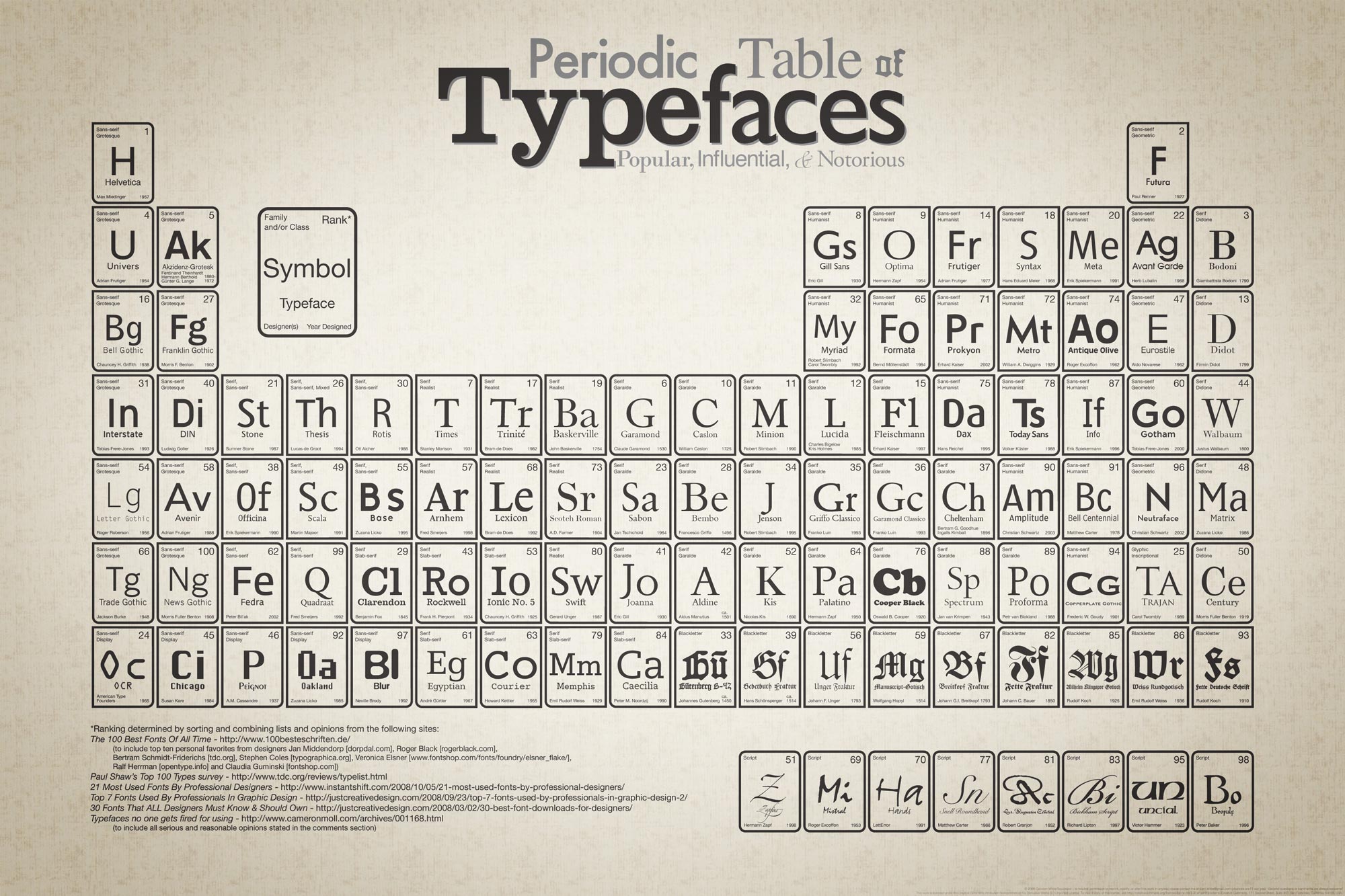One of the toughest jobs for in-house designers is choosing fonts. From the company logo (visible on all digital and print copy as well as signage) to copy on the website, it’s important to think carefully about the font you use to reflect your brand’s identity and establish a recognisable look.
Designers are fairly limited when it comes to web copy; you should set a fairly standard font so that it can be displayed by all browsers.
However, when it comes to print and graphic design you are free to play around with typography and can experiment with different typefaces or even create your own!

Periodic Table of Typefaces. Click for the full size version.
You can make small adjustments to a basic font (Arial, Helvetica, Tahoma etc.), download somebody else’s custom font from one of the many free font sites (check for commercial licensing first!) or even create your own custom typography.
As a branding tool, custom typography is the ideal solution. Customers will easily recognise media that belongs to you. Some people draw the line at creating custom text for just their business logo, but we recommend going a step further and creating an entire custom typeset.
You may need to hire in a typography expert but the tools are available for anybody to have a go using Adobe Illustrator. After attending our Illustrator workshop you will have all the skills needed to start creating your own typefaces, although we don’t cover typography in detail on the course. If this is something you are interested in learning we can tailor our courses to your requirements.
Once you have created your custom font, you can then use it in Photoshop & InDesign when editing and creating graphics for your web and print materials.
So why should you spend time and resources creating a custom typeset for your business? Here are my top 4 reasons!
Aaron Charlie
27 Jun 2012
The Plans theme is fundamental to the PRINCE2® methodology - the other themes (business case, organisation, quality, risk, change and progress) all depend on effective planning before, during and even after each project. A good plan will facilitate communication and control throughout the whole project life cycle.
Effective and structured planning also ensures that everyone involved in the project has the same information to work from and refer to. Crucially, in PRINCE2, all plans are created on a product-based technique – the final objective is identified first and then the plan is made of how to deliver this product.
Our PRINCE2 courses cover all of the PRINCE2 themes in detail, with a focus on real-life application of this knowledge.
The Planning Horizon
PRINCE2 can be applied to all scales of project, but detailed planning can be difficult for lengthier projects. If this is the case, the project will be broken down into smaller stages, and each of these will have separate plans. The planning horizon is the agreed length of time for which it is appropriate – or possible – to plan in detail.
Contents of PRINCE2 Plans
The different types of plans in a PRINCE2 project will follow a similar structure, in order to be easily accessible to everyone involved in the project. The level of detail that goes into each level of plan is determined by the scale of the project.
Andy Trainer
20 Jun 2012
What is the most effective way of improving my organisation?
Why does your organisation exist?
If it’s a commercial company, you want to make profits. If you are public sector or charity, then you want to apply your resources to best effect for your users.
Your business may be manufacturing (making widgets), information-processing (“transactional” such as finance and design) or service industry such as travel & transport, distribution, holidays and hotels. To make money (profit) you need to havefast and efficientthroughput of work from the start of the process to the customer.
What is Lean Six Sigma?

To improve flow of work and drive out waste (waste is anything you do that your customers won’t be happy paying for) many organisations use the highly effective tools of lean thinking. To reduce unwanted variation causing waste and troubling the customer we can use Six Sigma which is a powerful statistical toolkit. The combination of lean thinking and Six Sigma is Lean Six Sigma: widely and successfully used in very many organisations. Good training is available: for example, Silicon Beach Training offerLean Training&as well asSix SigmaYellow Belt(three days),Green Belt(five days) andBlack Belt Conversion(additional ten days).
Andy Trainer
13 Jun 2012
There is a simple but effective technique for determining the root cause without resorting to the more complex tools and techniques included in the Analyse section of the Six Sigma DMAIC methodology - covered in depth on our Root Cause Analysis course as well as our Lean Six Sigma Green Belt, Black Belt & Yellow Belt courses:
The 5 Whys

A question every parent and teacher will be very familiar with, asking why is a great way of winding people up. Every time you ask why, someone has to explain the last reason they gave - narrowing down or opening up the original statement until the asker is happy - which can go on for a long time with children.
What makes asking why a workable solution for determining the root cause of a problem?
- It is an easy tool that requires little statistical analysis
- You document each step of the analysis so you always know the path to the root cause
- The root cause is found more often that not
- Multiple root causes are often stumbled upon during the process
Why 5?
5 has been identified as the optimum number of ways needed to find the root cause of a problem. Most root causes are identified around the 5th question but some more complex problems lead to more questions being asked.
Andy Trainer
25 May 2012
Almost every person responsible for Health and Safety in the workplace has, at some point, had to consider how important the need for PAT testing is. Many people claim it’s a legal requirement – but is that a fact or a myth?
As we know that Health and Safety is so important to employers – yet surrounded by so much confusion - we offer a 4-day comprehensive Health and Safety course which is accredited by IOSH (the Institution of Occupational Safety and Health). Of course, protecting your employees from harm is your number one priority – but there are lots of other benefits of Health and Safety training as well.

Here are words from our trainer, Andrea, on the subject of PAT testing - and other Health and Safety myths.
Andy Trainer
21 May 2012
Trainers, in any subject or field, should be trained themselves. This sounds obvious, and so is often overlooked when considering a training provider.
Recipients receiving training of any kind from academic to athletic to in-company usually make the assumption that their trainer is a qualified and knowledgeable trainer. However, not all trainers are experts at what they teach or how to teach it (Except ours, of course, they're all fantastic!).
We strongly believe that all trainers should be trained both in the subject they teach and how to teach it - we make sure we are! That is why we run our Train the Trainer course, a highly popular workshop that teaches the best-practice adult training approach. You can find more about the course at the bottom of this article or by following the link.
Why is it important for trainers to be trained?
Expert Knowledge
|
It is important that trainers know what they are talking about - they should have a deep understanding of the subject the teach. Here are some of the reasons why
|

Andy Trainer
16 May 2012
Managers often have the heaviest workload in the department, especially when their management responsibilities are as well as another job role. Because the demands of being a manager can ebb and flow, it's especially important for managers to be aware of how they manage their time.
In particular, those who've recently been promoted to management may find themselves struggling with their new responsibilities on top of their old job.
Of everyone in the organisation, it's most likely that a

manager finds themselves with shifting priorities and unexpected demands through the working day - dealing with issues from the team can mean other work is left to pile up.
Here are our Top Ten Time Management Tips for Managers:
1. Plan - take time to make time
Time spent planning is not time wasted at the expense of doing. A bit of time spent in understanding what needs to be done, and planning how to achieve it, will have a massive return on investment. Training and coaching staff can seem like an interruption to other work, but will pay off in the long run.
Try not to plan for every moment of your day; leave time for dealing with unexpected tasks and for adapting to interruptions and changing priorities.
Andy Trainer
11 May 2012
Meeting government requirements for Health and Safety, of course, has the ultimate goal of protecting your employees from harm. You would not want a workplace accident on your conscience, or to feel responsible for long-term effects from work on someone’s health.
Further to this, having staff trained in IOSH Managing Safely means reduced insurance premiums, enhanced local reputation, increased productivity, reduced absence, and protects you against legal costs – or even imprisonment!
Within the company, the role of managing health and safety usually falls to a manager or supervisor. It is vital that they undertake training in Health and Safety law and practices in order to fulfil this role and protect the rest of the staff.
Here's some more on those ways that following Health and Safety practices can benefit your business:

1. Reduced Insurance Premiums
Proving that you have managers who are trained in Health and Safety issues will reduce your insurance premiums because, of course, it means you are less likely to make a claim. Not only that, but the actions taken to prevent injury or illness will mean those premiums stay low because no claims are made.
Andy Trainer
2 May 2012